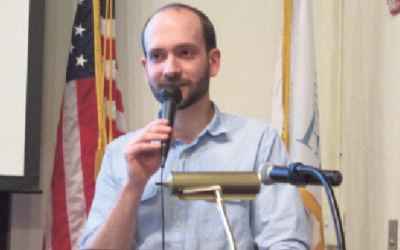Good government groups and Democratic legislators are trading accusations of gerrymandering and partisanship with Republicans over the county redistricting map proposed by Nassau County’s Republican legislative majority.
At a League of Women Voters forum in Great Neck on Wednesday, Nassau league co-president Jane Thomas, Common Cause New York research director Brian Paul and Democratic legislators Wayne Wink (Roslyn) and Judi Bosworth (Great Neck) assailed the GOP map as a partisan abuse of the redistricting process designed to dilute Democratic votes and assure a Republican majority for the next decade.
Republican Frank Moroney, who served as the non-voting chair of the Temporary Districting Advisory Commission and has led his party’s efforts to draw a new map, rejected those criticisms in an interview with Blank Slate Media and accused both the League of Women Voters and Common Cause of being in the tank for Democrats.
Paul presented a copy of the Republican map overlayed with party registration statistics, and said it was a clear attempt to pack Democrats into nine districts, leaving a 12-seat majority for Republicans. The GOP currently holds a 10-9 majority in the county Legislature.
“This is really a totally overt partisan gerrymander,” Paul said.
The map will be subject to a second public hearing Feb. 25 and is expected to be put to a vote on that date, ahead of the county charter’s March 5 deadline. The current map was drawn after the temporary districting commission, split on partisan lines, failed to produce a recommendation. The GOP map prepared for the commission would have divided Great Neck into two districts; the new plan keeps Great Neck united but splits other areas currently in one district, including Roslyn and the Five Towns.
Moroney called the criticism politically motivated and said the map was based on the legal requirements for redistricting, traditional redistricting principles including compactness, contiguity, preserving “communities of interest,” and public feedback. The Republican map was designed to ensure “one man one vote” by staying well within legal requirements for equally populated districts and includes three minority-majority districts, Moroney said. He described the map as “much fairer” than the current districting system.
“The people who oppose this map are partisans. We did everything the League of Women voters asked us to do and everything Common Cause asked us to do, and they’re not happy,” Moroney said.
At Wednesday night’s forum, representatives from the League of Women Voters and Common Cause disagreed with that assessment.
Thomas said the map’s placement of several Democratic incumbents within the same districts, including Wink and Glen Cove legislator Delia Deriggi-Whitton, was a power play by Republicans. The map would also merge the districts of Republicans Joseph Belisi (R-Farmingdale) and Michael Venditto (R-Massapequa).
“Gerrymandering is not our cup of tea,” Thomas said.
Paul said the map designed by the Nassau County United Redistricting Coalition, of which the League of Women Voters and Common Cause are members, sought to keep communities together – unlike the Republican map, which Paul said deliberately divided areas like Roslyn, Hicksville and the Five Towns into multiple districts.
Moroney said the Republican map protects minority representation, and when pressed on the shapes of the new districts – the proposed 14th District, for example, stretches in a narrow band from New Hyde Park to Bethpage – said that changes to the map had to made to account for shifting populations.
Moroney also disputed that Roslyn was a “community of interest”
“They share the same name, but Roslyn Country Club, their issues are more in tune with what goes on in Old Westbury and the areas that surround it,” Moroney said.
“What’s a community of interest? It’s in the eye of the beholder, like beauty,” he added.
The map was based on hearings and public feedback, Moroney said, and accused opponents of failing to make complaints until it suited them politically to do so.
“What are we supposed to do now? Go back and change the map and take out the things that people asked for?” Moroney said.
A Democratic map has also been drawn, which Democrats say makes far fewer changes to the current map than the Republican plan. It has not been introduced in the Legislature, and Moroney said the majority only has plans to vote on the Republican map.
Bosworth argued that the current map is currently competitive, as evidenced by the Republicans’ narrow majority in the chamber. Pointing to party registration statistics, Bosworth said the new map would guarantee Republicans a 12-7 majority and make a 13-6 supermajority possible – the margin needed to approve bonds.
“I feel it’s a danger whether it’s a supermajority of Republicans or Democrats,” she said.
“We were told the maps were drawn blind to incumbency. I’m not sure about that,” Bosworth said.
Wink alleged that the division of Roslyn into four districts was an attempt to dilute the influence of Roslyn’s voters.
“Roslyn is literally drawn and quartered,” he said. “It seems there’s very little justification for this.”
The map poses the threat of a supermajority that would allow for irresponsible borrowing, Wink said.
“My fear is that Nassau County’s fiscal future is reliant on overturning this map,” he said.
Should the map pass on Feb. 25, the issue will likely not be completely settled: both Republican and Democratic officials said they anticipate that a legal challenge is likely.



